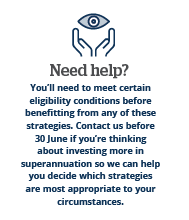Six super strategies to consider before 30 June 2022
With the end of financial year (EOFY) fast approaching, now is a great time
to boost your superannuation savings and potentially save on tax. Below
are six superannuation strategies to consider before 30 June 2022.
Tip 1 – Use the carry forward concessional contribution rules
If you want to make up for lost time and make extra contributions to top up your superannuation balance, you may be able to use the carry forward concessional contribution rules (otherwise known as “catch-up concessional” rules) to make large concessional contributions this year without exceeding your concessional contribution cap.
This strategy can allow you to carry forward any unused concessional contribution cap amounts that have accrued since 2018/19 for up to five financial years and use them to make concessional contributions in excess of the general annual concessional contribution cap (currently $27,500 in 2021/22).
You can then make a concessional contribution using the unused carry forward amounts this financial year provided your total superannuation balance (TSB) at 30 June 2021 was below $500,000.
Tip 2 – Make a personal deductible contribution
Carry-forward contributions may also provide you with an opportunity to make higher amounts of personal deductible contributions in financial years where you may have a higher level of taxable income, for example, due to assessable capital gains.
But if you’re not eligible to use the carry forward rules to make a larger contribution, you can still boost your superannuation by making a personal deductible contribution up to the general concessional contribution cap.
It’s important to note that personal deductible contributions are only deductible if you meet all of the following conditions:
You make the contribution to a complying superannuation fund
You are at least age 18 when the contribution is made (unless you derived income from carrying on a business or from employment related activities)
You make the contribution within 28 days after the month in which you turn 75
You notify your superannuation fund trustee in writing of your intention to claim the deduction
The notice must be given by the earlier of:
> when you lodge your income tax return for the year the contributions were made, or
> the end of the financial year following the year the contributions were made
The trustee of your superannuation fund must acknowledge receipt of the notice, and you cannot deduct more than the amount stated in the notice.
Tip 3 – Spouse contribution splitting
You can split up to 85% of your 2020/21 concessional contributions before 30 June 2022 to your spouse’s superannuation account if your spouse is:
Less than the preservation age, or
Between preservation age and age 64 (and you must declare they do not satisfy the 'retirement' condition of release).
This is an effective way of building superannuation for your spouse and can assist to manage your TSB which can have several advantages, including:
Equalising balances to make best use of both of your transfer balance caps (TBC), which can maximise the amount you both have invested in tax-free retirement phase income streams
Optimising both of your TSBs to:
> Access a higher non-concessional contribution (NCC) cap
> Allow access to use the carry-forward concessional contribution rules
> Utilise the work test exemption
> Qualify for a government co-contribution
> Qualify for a tax offset for spouse contributions
Boosting Centrelink entitlements by transferring funds into a younger spouse’s accumulation account if your spouse is under age pension age.
Tip 4 – Superannuation spouse tax offset
If your spouse is not working or earns a low income, you may want to consider making an NCC into their superannuation account.
This strategy could benefit you both by boosting your spouse’s superannuation account and allowing you to qualify for a tax offset of up to $540.
You may be able to get the full offset if you contribute $3,000 and your spouse earns $37,000 or less pa (including their assessable income, reportable fringe benefits and reportable employer superannuation contributions).
A lower tax offset may be available if you contribute less than $3,000, or your spouse earns between $37,000 and $40,000 pa.
Tip 5 – Maximise non-concessional contributions
Another way to boost your superannuation is to make an NCC with some of your after-tax income or savings.
The general NCC cap for 2021/22 is $110,000 and eligibility to utilise the cap depends on your TSB.
Although NCCs don’t reduce your taxable income for the year, you can still benefit from the low tax rate of up to 15% that is paid in superannuation on investment earnings. This tax rate may be lower than what you might pay if you held the money in other investments outside superannuation.
Tip 6 – Receive the government co-contribution
If you're a low or middle-income earner earning less than $56,112 in 2021/22 and at least 10% is from your job or a business, you may want to consider making an NCC to superannuation before 1 July 2022. If you do, the Government may make a ‘co-contribution’ of up to $500 into your superannuation account.
The maximum co-contribution is available if you contribute $1,000 and earn $41,112 pa or less. You may receive a lower amount if you contribute less than $1,000 and/or earn between $41,112 and $56,112 pa.
Like the superannuation spouse tax offset, the definition of ‘total income’ for the purposes of the co-contribution includes assessable income, reportable fringe benefits and reportable employer superannuation contributions.



